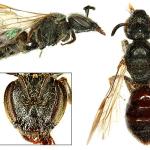Lasioglossum atricorne SMITH F 1870
One of a group of medium-sized, predominantly black, Lasioglossum bees which require care in identification and which are unlikely to be easily recognised in the field. This is a species which is distributed throughout the northern regions of both the New and Old World, although it is montane in the southern parts of its range.
A northern species which is very scarce in the extreme south of the British Isles, but may be common further north.
This bee is not regarded as being scarce or threatened.
This species occupies a wide range of habitat types.
Females are found between April and October, males between July and September. As with all British Lasioglossum, only mated females hibernate.
A solitary species which nests in exposed soils on upturned root-plates, ditch edges and cliffs.
In the British Isles has been recorded visiting bramble (Rubus spp.) and ragwort (Senecio jacobaea).
Both the cleptoparasitic bees Sphecodes ferruginatus and Nomada fabriciana have been suggested as parasites of this species. Confirmatory evidence from reared material is required.
2005


